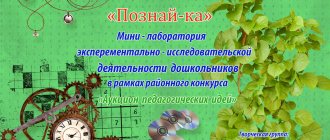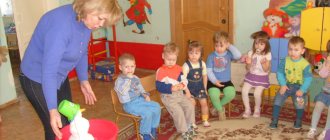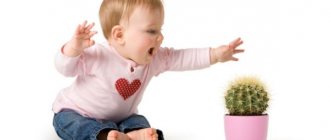Natalia Davydova
Experimental research activities in the senior group
Experimental research activities in senior group No. 8 “Dolphin”
.
Date: 03/21/2019
Participants: teacher, children of senior group No. 8 ( subgroup 10 people )
.
Equipment: 1 experiment : “Mystery paper”
.
Three plastic glasses (for each child, a sheet of paper.
Experiment 2 : “Birds and Oil”
.
Vegetable oil, feather, saucer, napkin (for each child)
.
1 Experiment : "Mystery Paper"
.
Goal: - Formation in children of knowledge and ideas about paper and its properties;
— Draw children’s attention to the importance and diversity of paper in our lives.
Objectives: - To provide knowledge about the properties of paper, to do experiments with paper;
— Activate children’s speech, thinking, attention, interest in
experimental activities;
— Develop fine motor skills and design skills;
— Draw children’s attention to the need for careful use
paper, on the connection between forest protection and our everyday life.
Progress of the lesson.
Playback The next experiment is called “Birds and Oil”
.
There is a bird feather in front of you.
You need to throw a feather, blow on it and carefully follow it. What's happening? That's right, it floats in the air. Now dip it in the rast. Oil (oil also has an oily structure)
and throw it up again.
What's happening to him? That's right, it falls down quickly. The structure of feathers allows birds to fly by “pushing” the air down with their wings, while they themselves rise up. When a waterfowl (duck, gull, loon, swan)
lands on water covered with an oil film, its feathers become dirty. They stick together and lose the ability to “repel” air, which means the bird cannot take off and may die or become easy prey for predators. From this we can conclude that we need to help birds and other animals and not pollute the environment.
Long-term plan for experimental activities in the senior group
Belikova Lyubov
Long-term plan for experimental activities in the senior group
Long-term work plan
on experimental activities of children
in the senior group
Before giving knowledge, it is necessary
teach you to think, perceive,
observe.
V. Sukhomlinsky
Throughout preschool childhood, along with play activities activity is of great importance in the development of the child’s personality, in the processes of socialization , which we understand not only as the process of acquiring knowledge, skills and abilities, but, mainly, as the search for knowledge, the acquisition of knowledge independently or under the tactful guidance of an adult, carried out in the process of humanistic interaction, cooperation, co-creation.
A Chinese proverb says: “Tell me and I will forget, show me and I will remember, let me try and I will understand.” Everything is assimilated firmly and for a long time when the child hears, sees and does it himself. This is the basis for the active introduction of children's experimentation into the practice of preschool institutions.
The works of many domestic teachers speak of the need to include preschoolers in meaningful activities , during which they themselves would be able to discover more and more new properties of objects, their similarities and differences, and to provide them with the opportunity to acquire knowledge on their own (G, M, Lyamina, A. P. Usova, E. A. Panko, etc.)
.
In the process of experimentation, preschoolers have the opportunity to satisfy their inherent curiosity (why? why? how? what would happen if, to feel like a scientist, researcher, discoverer.
They experience great joy, surprise and even delight from their small and big “discoveries”
that give children a feeling of satisfaction from the work done.
Of particular importance for children of senior preschool age is their acquisition of ideas about the relationship between nature and man. In this age group, The materials located in the experimentation corner are distributed into different sections, which are located in a place accessible for free experimentation and in sufficient quantity. It is advisable to have different equipment in the experimentation corner:
• Assistant devices: magnifying glasses;
• A variety of vessels from various materials of different volumes and shapes;
• Natural material;
• Medical materials;
• Other materials.
The material in the experimentation corner must correspond to the average level of development of the child. It is also necessary to have materials and equipment to conduct more complex experiments designed for gifted children and children with a high level of development.
September.
1. “What kind of water?”
- form ideas about water and its properties.
( "
Experiments , games, experiments p. 142" )
2. “Where did the water go?”
— acquaintance with the properties of water (
“
Experiments , games, experiments p. 142” )
3. “Transparent water” - expansion of ideas about the properties of water - odorless, transparent, flows, has weight. ( " Experiments , games, experiments"
page 66)
4. "Surface Tension of Water"
— Form ideas about the properties of water.
( "
Experiments , games, experiments" p. 215)
October.
1. "Tornado in a Bottle"
(
"
Experiments , games, experiments" p. 101)
2. “Thermometer and temperature” - the formation of ideas about the temperature of the environment and one’s own body. ( " Experiments , games, experiments"
page 82)
3. “Clocks and time” - the formation of ideas about time. ( Experiments , games, experiments. p. 83)
4. “Gas-property of air” - development of the ability to establish cause-and-effect relationships based on elementary experiments and draw conclusions. ( " Experiments , games, experiments"
page 90)
November.
1. “Why does the change of day and night occur” - development of skills to establish cause-and-effect relationships. ( " Experiments , games, experiments p. 86"
)
2. "Change of Seasons"
- development of children's logical thinking.
( "
Experiments , games, experiments" p. 87)
3 "Earth on the Globe"
— Develop cognitive interest.
( "
Experiments , games, experiments" p. 84)
4. “We will see everything, we will know everything” - the formation of ideas about a magnifying glass - a magnifying glass. ( " Experiments , games, experiments"
page 72)
December.
1. "The Amazing Properties of Ice"
— expansion of ideas about the properties of ice.
( "
Experiments , games, experiments" p. 78)
2. "Little Wizards"
- expanding knowledge about the properties of ice, updating knowledge about the properties of wood and magnet.
Develop the ability to formulate a problem. ( "
Experiments , experiments, games" p. 203)
3. "Ice Sailboats"
— Develop knowledge that ice is lighter than water and can float.
Promote the development of the respiratory system. ( "
Experiments , experiments, games" p. 214)
4. "Melting Ice"
— formation of ideas about the properties of ice.
( "
Experiments , experiments, games" p. 71)
January.
1. Games for the development of auditory perception
"Find the same sound"
(
"
Experiments , experiments, games" p. 197)
2. Games for the development of tactile-motor perception
“Wonderful pouches of polar bear cubs”
(
"
Experiments , experiments, games" p. 198)
3. Games to develop taste perception.
"Taste cups"
(
"
Experiments , experiments, games" p. 199)
4. Games to develop the sense of smell.
"Alluring jars"
(
"
Experiments , experiments, games" p. 200)
February.
1. “Let’s grow crystals”
introducing children to the properties of water and salt.
“
Experiments , games, experiments p. 222” 2. “Properties of salt”
Formation of ideas about the properties of salt.
“
Experiments , games, experiments p. 59” 3. “Soap bubbles”
Form ideas about the properties of soap.
(
Experiments , games, experiments p. 64.) 4. “Light - heavy” - formulate an idea of the properties of the stone. ( " Experiments , games, experiments"
page 195)
March.
1. “What kind of pebbles are there?”
– to form an idea of the variety of stones, their characteristics, and meaning for humans.
( "
Experiments , games, experiments" p. 156)
2. "Solid as a Rock Part 1"
– form ideas about the properties of stones.
( "
Experiments , games, experiments" p. 156)
3. "Solid as a Rock Part 2"
– form ideas about the properties of stones.
( "
Experiments , games, experiments" p. 156)
4. "Water like stone"
- form ideas about the properties of stones.
( "
Experiments , games, experiments" p. 156)
April.
1. “Sources of sound and its distribution”
— development of cognitive activity in the process of analyzing various sounds.
( "
Experiments , games, experiments" p. 98)
2."Soil pollution"
- form ideas about the properties of soil.
( "
Experiments , games, experiments" p. 157)
3. "Soil and underground inhabitants"
- form ideas about the properties of soil.
( "
Experiments , games, experiments" p. 156)
4. "Soil and Air"
- form ideas about the properties of soil.
( "
Experiments , games, experiments" p. 157)
May.
1. Playing with sand outside
“Whose trace?”
(
"
Experiments , games, experiments" p. 172)
2. «Experience with plants»
– form ideas about the need for moisture for plant growth.
( "
Experiments , games, experiments" p. 177)
3. «Experience with plants»
– form ideas about the need for light for plant growth.
( "
Experiments , games, experiments" p. 177)
4. «Experience with plants»
– form ideas about the need for heat for plant growth.
( "
Experiments , games, experiments" p. 177)
Long-term work plan
on experimental activities of children
in the senior group
Before giving knowledge, it is necessary
teach you to think, perceive,
observe.
V. Sukhomlinsky
Throughout preschool childhood, along with play activities activity is of great importance in the development of the child’s personality, in the processes of socialization , which we understand not only as the process of acquiring knowledge, skills and abilities, but, mainly, as the search for knowledge, the acquisition of knowledge independently or under the tactful guidance of an adult, carried out in the process of humanistic interaction, cooperation, co-creation.
A Chinese proverb says: “Tell me and I will forget, show me and I will remember, let me try and I will understand.” Everything is assimilated firmly and for a long time when the child hears, sees and does it himself. This is the basis for the active introduction of children's experimentation into the practice of preschool institutions.
The works of many domestic teachers speak of the need to include preschoolers in meaningful activities , during which they themselves would be able to discover more and more new properties of objects, their similarities and differences, and to provide them with the opportunity to acquire knowledge on their own (G, M, Lyamina, A. P. Usova, E. A. Panko, etc.)
.
In the process of experimentation, preschoolers have the opportunity to satisfy their inherent curiosity (why? why? how? what would happen if, to feel like a scientist, researcher, discoverer.
They experience great joy, surprise and even delight from their small and big “discoveries”
that give children a feeling of satisfaction from the work done.
Of particular importance for children of senior preschool age is their acquisition of ideas about the relationship between nature and man. In this age group, The materials located in the experimentation corner are distributed into different sections, which are located in a place accessible for free experimentation and in sufficient quantity. It is advisable to have different equipment in the experimentation corner:
• Assistant devices: magnifying glasses;
• A variety of vessels from various materials of different volumes and shapes;
• Natural material;
• Medical materials;
• Other materials.
The material in the experimentation corner must correspond to the average level of development of the child. It is also necessary to have materials and equipment to conduct more complex experiments designed for gifted children and children with a high level of development.
September.
1. “What kind of water?”
- form ideas about water and its properties.
( "
Experiments , games, experiments p. 142" )
2. “Where did the water go?”
— acquaintance with the properties of water (
“
Experiments , games, experiments p. 142” )
3. “Transparent water” - expansion of ideas about the properties of water - odorless, transparent, flows, has weight. ( " Experiments , games, experiments"
page 66)
4. "Surface Tension of Water"
— Form ideas about the properties of water.
( "
Experiments , games, experiments" p. 215)
October.
1. "Tornado in a Bottle"
(
"
Experiments , games, experiments" p. 101)
2. “Thermometer and temperature” - the formation of ideas about the temperature of the environment and one’s own body. ( " Experiments , games, experiments"
page 82)
3. “Clocks and time” - the formation of ideas about time. ( Experiments , games, experiments. p. 83)
4. “Gas-property of air” - development of the ability to establish cause-and-effect relationships based on elementary experiments and draw conclusions. ( " Experiments , games, experiments"
page 90)
November.
1. “Why does the change of day and night occur” - development of skills to establish cause-and-effect relationships. ( " Experiments , games, experiments p. 86"
)
2. "Change of Seasons"
- development of children's logical thinking.
( "
Experiments , games, experiments" p. 87)
3 "Earth on the Globe"
— Develop cognitive interest.
( "
Experiments , games, experiments" p. 84)
4. “We will see everything, we will know everything” - the formation of ideas about a magnifying glass - a magnifying glass. ( " Experiments , games, experiments"
page 72)
December.
1. "The Amazing Properties of Ice"
— expansion of ideas about the properties of ice.
( "
Experiments , games, experiments" p. 78)
2. "Little Wizards"
- expanding knowledge about the properties of ice, updating knowledge about the properties of wood and magnet.
Develop the ability to formulate a problem. ( "
Experiments , experiments, games" p. 203)
3. "Ice Sailboats"
— Develop knowledge that ice is lighter than water and can float.
Promote the development of the respiratory system. ( "
Experiments , experiments, games" p. 214)
4. "Melting Ice"
— formation of ideas about the properties of ice.
( "
Experiments , experiments, games" p. 71)
January.
1. Games for the development of auditory perception
"Find the same sound"
(
"
Experiments , experiments, games" p. 197)
2. Games for the development of tactile-motor perception
“Wonderful pouches of polar bear cubs”
(
"
Experiments , experiments, games" p. 198)
3. Games to develop taste perception.
"Taste cups"
(
"
Experiments , experiments, games" p. 199)
4. Games to develop the sense of smell.
"Alluring jars"
(
"
Experiments , experiments, games" p. 200)
February.
1. “Let’s grow crystals”
introducing children to the properties of water and salt.
“
Experiments , games, experiments p. 222” 2. “Properties of salt”
Formation of ideas about the properties of salt.
“
Experiments , games, experiments p. 59” 3. “Soap bubbles”
Form ideas about the properties of soap.
(
Experiments , games, experiments p. 64.) 4. “Light - heavy” - formulate an idea of the properties of the stone. ( " Experiments , games, experiments"
page 195)
March.
1. “What kind of pebbles are there?”
– to form an idea of the variety of stones, their characteristics, and meaning for humans.
( "
Experiments , games, experiments" p. 156)
2. "Solid as a Rock Part 1"
– form ideas about the properties of stones.
( "
Experiments , games, experiments" p. 156)
3. "Solid as a Rock Part 2"
– form ideas about the properties of stones.
( "
Experiments , games, experiments" p. 156)
4. "Water like stone"
- form ideas about the properties of stones.
( "
Experiments , games, experiments" p. 156)
April.
1. “Sources of sound and its distribution”
— development of cognitive activity in the process of analyzing various sounds.
( "
Experiments , games, experiments" p. 98)
2."Soil pollution"
- form ideas about the properties of soil.
( "
Experiments , games, experiments" p. 157)
3. "Soil and underground inhabitants"
- form ideas about the properties of soil.
( "
Experiments , games, experiments" p. 156)
4. "Soil and Air"
- form ideas about the properties of soil.
( "
Experiments , games, experiments" p. 157)
May.
1. Playing with sand outside
“Whose trace?”
(
"
Experiments , games, experiments" p. 172)
2. «Experience with plants»
– form ideas about the need for moisture for plant growth.
( "
Experiments , games, experiments" p. 177)
3. «Experience with plants»
– form ideas about the need for light for plant growth.
( "
Experiments , games, experiments" p. 177)
4. «Experience with plants»
– form ideas about the need for heat for plant growth.
( "
Experiments , games, experiments" p. 177)



